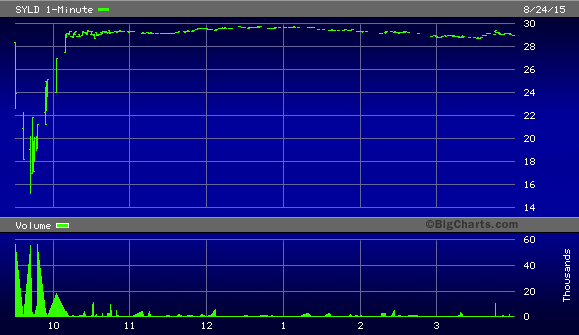Strike While The Iron Is Hot
I don’t usually drink on a Monday afternoon. But this week, I made an exception. Once the market had closed, I snuck out of the office for a cold beer (a Shiner Bock, of course). And then I ordered a second one. It had been that kind of day.
But here’s the thing: While wild market volatility is nerve wracking, these are the days when the best opportunities present themselves. I’m not bragging or exaggerating when I say that I made 30% in about 15 minutes Monday, and I did so while taking no risk whatsoever.
No, I’m not that good. I got lucky. I happened to stumble into a mispriced security, and I struck while the iron was hot.
Let me give you the details. I opened my trading screen to find that an ETF I owned, the Cambria Shareholder Yield ETF (SYLD) had dropped by 50% in value. It had lost half its value from Friday’s close.

Remember, ETFs are not stocks. They are exchange-traded mutual funds that, by their very construction, are supposed to follow an index. At least in theory, an ETF’s price can never deviate too far from the index it tracks because large institutional investors would be able to earn a risk-free arbitrage profit by creating or destroying shares.
In the case of SYLD, we had a mispricing that was theoretically impossible. The ETF’s price was down by 50%…while the actual portfolio of stocks that SYLD tracks were down maybe 4% at most. In a normal functioning market, a large trader could earn a risk free profit by buying up a large block of shares of SYLD, breaking the apart, and selling the underlying portfolio stock in the market.
But on a trading day like Monday, you don’t have a normal, functioning market, and you get mispricings like these. (SYLD wasn’t the only ETF whose pricing became untethered from reality. It’s just the only one I happened to be trading at the time.)
I did what any rational investor would do: I plowed every dollar I could find into SYLD shares before the mispricing window closed. I made about 30% in 15 minutes, sold the shares and went on about my day.
I tell this story not to toot my own horn. I’m the first to admit that I got phenomenally lucky here. But there are definitely some lessons we can learn from this.
- To start, ETFs – and particularly niche ETFs like SYLD – can be thinly traded and illiquid. SYLD has an average daily trading volume of less than 30,000 shares per day. That’s a problem if you are a large shareholder and you want to unload your shares in a hurry. You run the risk of moving the market, and that’s exactly what happened Monday.
- But this same illiquidity can create fantastic short-term opportunities if you’re willing to take the other side of the trade and you are small and nimble enough to act. If I had been running a multi-billion-dollar hedge fund, I wouldn’t have been able to make this trade. Given the small number of shares that traded, I wouldn’t have been able to place a large enough order to matter or my orders wouldn’t have been filled in time.
- I was also able to jump on this because I wasn’t fully invested. I had a little dry powder… just in case. In order to take advantage of opportunities like these, you need to keep a little cash on hand.
Keep your eyes open. We’ll have more volatility in the months to come… and plenty of good short-term opportunities.



